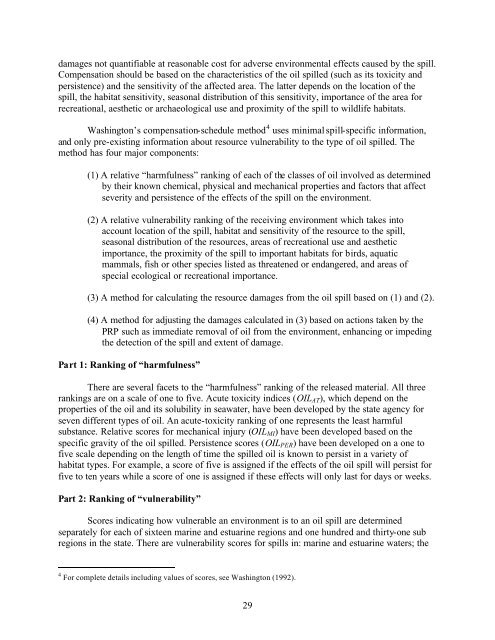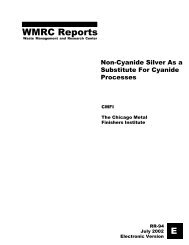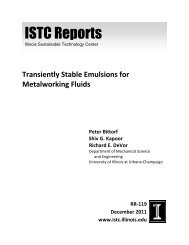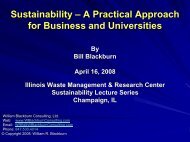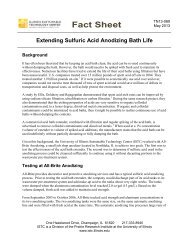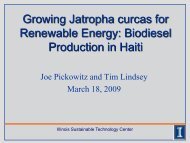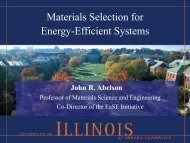Natural Resource Damage Assessment: Methods and Cases
Natural Resource Damage Assessment: Methods and Cases
Natural Resource Damage Assessment: Methods and Cases
Create successful ePaper yourself
Turn your PDF publications into a flip-book with our unique Google optimized e-Paper software.
damages not quantifiable at reasonable cost for adverse environmental effects caused by the spill.<br />
Compensation should be based on the characteristics of the oil spilled (such as its toxicity <strong>and</strong><br />
persistence) <strong>and</strong> the sensitivity of the affected area. The latter depends on the location of the<br />
spill, the habitat sensitivity, seasonal distribution of this sensitivity, importance of the area for<br />
recreational, aesthetic or archaeological use <strong>and</strong> proximity of the spill to wildlife habitats.<br />
Washington’s compensation-schedule method 4 uses minimal spill-specific information,<br />
<strong>and</strong> only pre-existing information about resource vulnerability to the type of oil spilled. The<br />
method has four major components:<br />
(1) A relative “harmfulness” ranking of each of the classes of oil involved as determined<br />
by their known chemical, physical <strong>and</strong> mechanical properties <strong>and</strong> factors that affect<br />
severity <strong>and</strong> persistence of the effects of the spill on the environment.<br />
(2) A relative vulnerability ranking of the receiving environment which takes into<br />
account location of the spill, habitat <strong>and</strong> sensitivity of the resource to the spill,<br />
seasonal distribution of the resources, areas of recreational use <strong>and</strong> aesthetic<br />
importance, the proximity of the spill to important habitats for birds, aquatic<br />
mammals, fish or other species listed as threatened or endangered, <strong>and</strong> areas of<br />
special ecological or recreational importance.<br />
(3) A method for calculating the resource damages from the oil spill based on (1) <strong>and</strong> (2).<br />
(4) A method for adjusting the damages calculated in (3) based on actions taken by the<br />
PRP such as immediate removal of oil from the environment, enhancing or impeding<br />
the detection of the spill <strong>and</strong> extent of damage.<br />
Part 1: Ranking of “harmfulness”<br />
There are several facets to the “harmfulness” ranking of the released material. All three<br />
rankings are on a scale of one to five. Acute toxicity indices (OILAT), which depend on the<br />
properties of the oil <strong>and</strong> its solubility in seawater, have been developed by the state agency for<br />
seven different types of oil. An acute-toxicity ranking of one represents the least harmful<br />
substance. Relative scores for mechanical injury (OILMI) have been developed based on the<br />
specific gravity of the oil spilled. Persistence scores (OILPER) have been developed on a one to<br />
five scale depending on the length of time the spilled oil is known to persist in a variety of<br />
habitat types. For example, a score of five is assigned if the effects of the oil spill will persist for<br />
five to ten years while a score of one is assigned if these effects will only last for days or weeks.<br />
Part 2: Ranking of “vulnerability”<br />
Scores indicating how vulnerable an environment is to an oil spill are determined<br />
separately for each of sixteen marine <strong>and</strong> estuarine regions <strong>and</strong> one hundred <strong>and</strong> thirty-one sub<br />
regions in the state. There are vulnerability scores for spills in: marine <strong>and</strong> estuarine waters; the<br />
4 For complete details including values of scores, see Washington (1992).<br />
29


